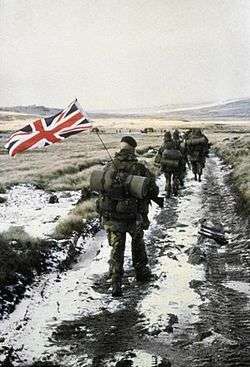Yomp

Yomp is Royal Marines slang describing a long-distance march carrying full kit. The origin of the word is unclear (one suggestion would interpret it as an acronym of Your Own Marching Pace[1]). It was popularized by journalistic coverage in 1982 during the Falklands War. "Yomp" has been compared to the term yump used in rally-driving in the sense of "to leave the ground when taking a crest at speed", apparently a variant of jump.[2]
The most famous yomp of recent times was during the 1982 Falklands War. After disembarking from ships at San Carlos on East Falkland, on 21 May 1982, Royal Marines and members of the Parachute Regiment yomped (and tabbed) with their equipment across the islands, covering 56 miles (90 km)[3] in three days carrying 80-pound (36 kg)[4] loads.
Synonyms
British Army slang for the same concept is "T.A.B.", of equally unknown origin. (One suggestion would interpret it as an acronym of Tactical Advance to Battle[5])
US Military slang for this concept is to "ruck" (from the "rucksack" being carried) or to "hump" from the phrase "humping a pack".
The Yomper
The image of "the Yomper" became one of the iconic images of the Falklands War.[6][7] The original photograph was taken by Petty Officer Peter Holdgate, Commando Forces Photographer, whilst working as part of the Commando Forces News Team. After landing with 40 Commando at San Carlos, Holdgate accompanied British forces across the Falklands War zone taking hundreds of photographs. The photograph of 24-year-old Corporal Peter Robinson was taken in June 1982 as the Royal Marines proceeded along the Moody Brook track towards Stanley.[8]
_cropped.jpg)
When news of the surrender of Argentine forces was received, Corporal Brennan produced a small Union bunting flag from his bergen (borrowed from SS Canberra's bunting locker). Marine Fraser first tied the flag to Corporal Brennan's radio aerial, which eventually blew off. It was then fixed with masking tape to the radio aerial of Corporal Robinson (who was the last man in the patrol). The photograph itself was entirely spontaneous and not staged. The original Union Flag was returned to Corporal Brennan in Stanley, who has it in his possession to this day.
The image was used as the inspiration of a statue[9] that was unveiled by Lady Margaret Thatcher on 8 July 1992 on the 10th anniversary of the conflict. It now adorns the entrance to the Royal Marines Museum in Southsea.
In popular culture
Media coverage of this war saw the term "yomp" become well known and enter general use. However, the term has since faded somewhat from general use in the decades since the end of the Falklands war.
In games
- Virgin Games, Inc. published a computer game called Yomp (1983) shortly after the Falklands conflict.
In literature
- In Charlie Higson's second novel in The Enemy series, titled The Dead (2010), Bam tells Greg, "I grew up in the country, you see, always out yomping 'round the fields."[10]
See also
References
- ↑ Your Own Marching Pace. The Free Dictionary.
- ↑ Ayto, John (2006). Movers And Shakers: A Chronology of Words That Shaped Our Age. Oxford University Press. p. 225.
- ↑ Freedman, Lawrence (1990). "The Bridgehead and Beyond". Signals of War, The Falklands Conflict of 1982. London: Faber and Faber: Chapter 21. ISBN 978-0-571-14116-6. "There were two considerations. First, the distance between Stanley and San Carlos was some 56 miles and given the problems posed by the terrain it would take at least eight days to cover the ground. Movement would be 'under constant enemy fire from the air, in an area without cover, wood, drinking water or means of subsistence'. When his men arrived, worn out by the long trek, they would have to go into immediate action against an enemy well prepared and supported by field artillery."
- ↑ Bernard Fitzsimons (Editor) (1987). Modern Land Combat. Salamander Books Ltd. ISBN 978-1-85501-165-6.
- ↑ "TAB". Acronym Finder.
- ↑ Rees, Alun (21 April 2007), "Revealed at last: face of Falklands 'yomping' Marine", Daily Mail
- ↑ Dunn, Tom Newton (30 May 2007), "'I was one of the lucky ones'", The Sun
- ↑ "Memorials and Monuments in the Royal Marines Museum, Portsmouth (The Yomper)" (ISO-8859-1). 20 December 2006.
- ↑ "Memorials and Monuments in the Royal Marines Museum, Portsmouth (The Yomper)" (ISO-8859-1). 20 December 2006.
- ↑ Higson, Charlie (2010). The Dead. Puffin Books. p. 5 of 6, Chapter 25. Missing or empty
|title=(help)